Organizational and Leadership Behavior at Smith's Restaurant Report
VerifiedAdded on 2021/08/10
|22
|3755
|36
Report
AI Summary
This report analyzes the organizational behavior within Smith's Restaurant, examining its structure, culture, and leadership styles. It explores the entrepreneurial structure and power culture implemented by Mr. Smith, highlighting the impact of leadership on employee behavior and motivation. The report delves into various factors influencing behavior, including psychological factors, individual differences, and motivation theories such as Maslow's hierarchy of needs and Herzberg's two-factor theory. It discusses different management approaches, leadership styles, and the nature of groups, including formal and informal groups, and the factors contributing to effective teamwork. The report also assesses the relationship between motivation theories and management practices, providing recommendations for improving employee engagement and organizational performance. The report concludes with a discussion on dealing with conflicts, responsibilities, and the overall implications of organizational behavior within the context of the restaurant's expansion plans.
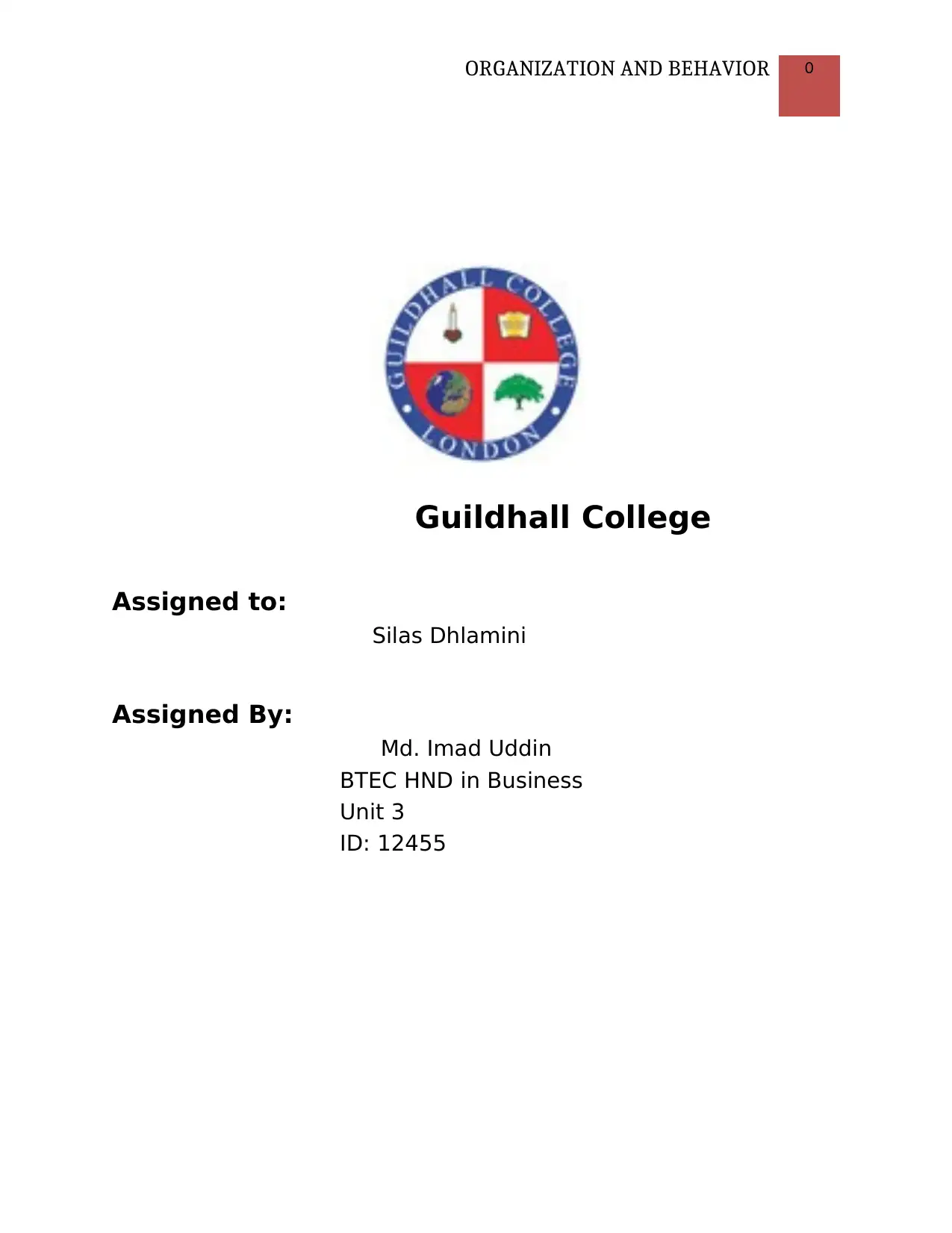
ORGANIZATION AND BEHAVIOR 0
Guildhall College
Assigned to:
Silas Dhlamini
Assigned By:
Md. Imad Uddin
BTEC HND in Business
Unit 3
ID: 12455
Guildhall College
Assigned to:
Silas Dhlamini
Assigned By:
Md. Imad Uddin
BTEC HND in Business
Unit 3
ID: 12455
Paraphrase This Document
Need a fresh take? Get an instant paraphrase of this document with our AI Paraphraser
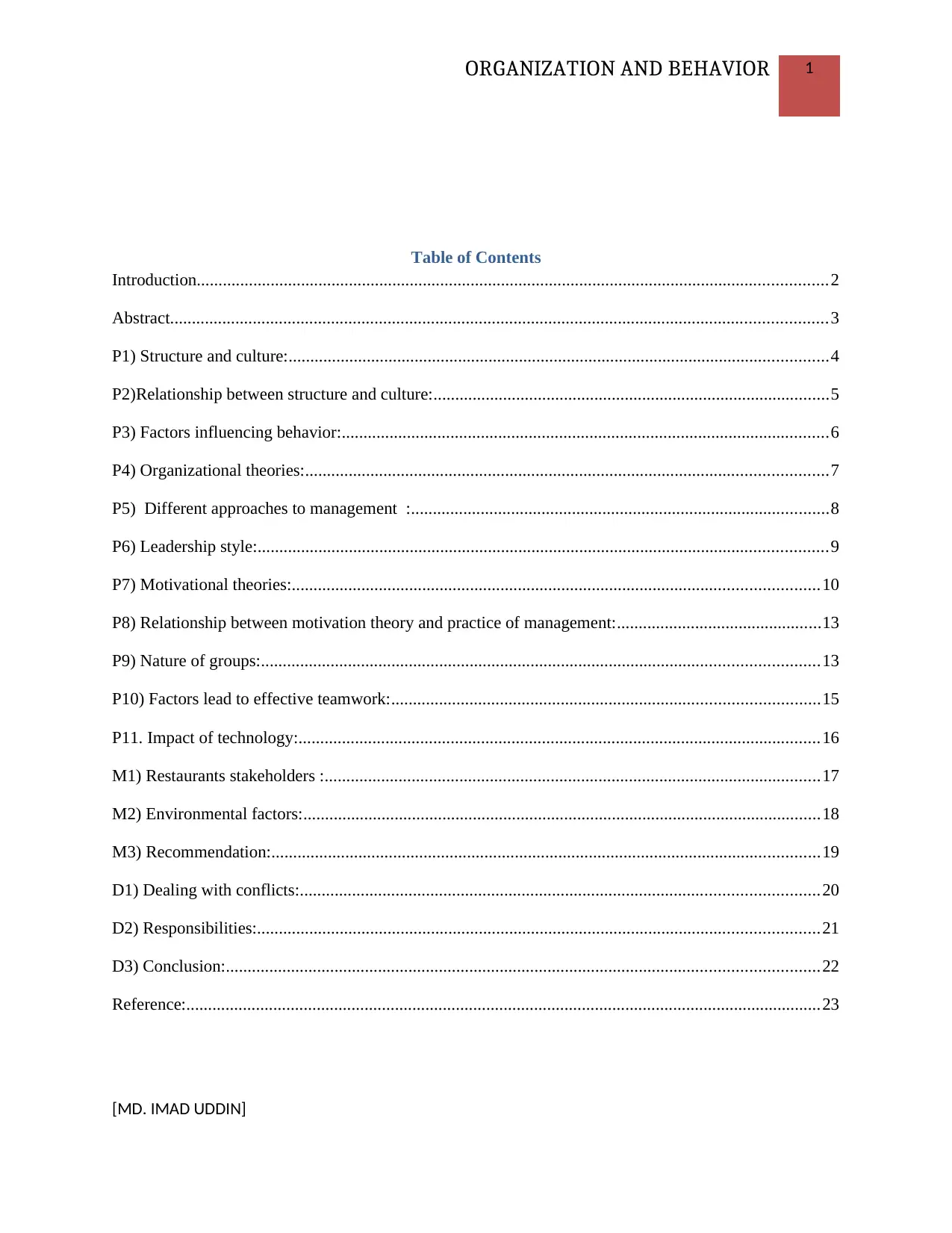
ORGANIZATION AND BEHAVIOR 1
Table of Contents
Introduction.................................................................................................................................................2
Abstract.......................................................................................................................................................3
P1) Structure and culture:............................................................................................................................4
P2)Relationship between structure and culture:...........................................................................................5
P3) Factors influencing behavior:................................................................................................................6
P4) Organizational theories:........................................................................................................................7
P5) Different approaches to management :................................................................................................8
P6) Leadership style:...................................................................................................................................9
P7) Motivational theories:.........................................................................................................................10
P8) Relationship between motivation theory and practice of management:...............................................13
P9) Nature of groups:................................................................................................................................13
P10) Factors lead to effective teamwork:..................................................................................................15
P11. Impact of technology:........................................................................................................................16
M1) Restaurants stakeholders :..................................................................................................................17
M2) Environmental factors:.......................................................................................................................18
M3) Recommendation:..............................................................................................................................19
D1) Dealing with conflicts:.......................................................................................................................20
D2) Responsibilities:.................................................................................................................................21
D3) Conclusion:........................................................................................................................................22
Reference:..................................................................................................................................................23
[MD. IMAD UDDIN]
Table of Contents
Introduction.................................................................................................................................................2
Abstract.......................................................................................................................................................3
P1) Structure and culture:............................................................................................................................4
P2)Relationship between structure and culture:...........................................................................................5
P3) Factors influencing behavior:................................................................................................................6
P4) Organizational theories:........................................................................................................................7
P5) Different approaches to management :................................................................................................8
P6) Leadership style:...................................................................................................................................9
P7) Motivational theories:.........................................................................................................................10
P8) Relationship between motivation theory and practice of management:...............................................13
P9) Nature of groups:................................................................................................................................13
P10) Factors lead to effective teamwork:..................................................................................................15
P11. Impact of technology:........................................................................................................................16
M1) Restaurants stakeholders :..................................................................................................................17
M2) Environmental factors:.......................................................................................................................18
M3) Recommendation:..............................................................................................................................19
D1) Dealing with conflicts:.......................................................................................................................20
D2) Responsibilities:.................................................................................................................................21
D3) Conclusion:........................................................................................................................................22
Reference:..................................................................................................................................................23
[MD. IMAD UDDIN]
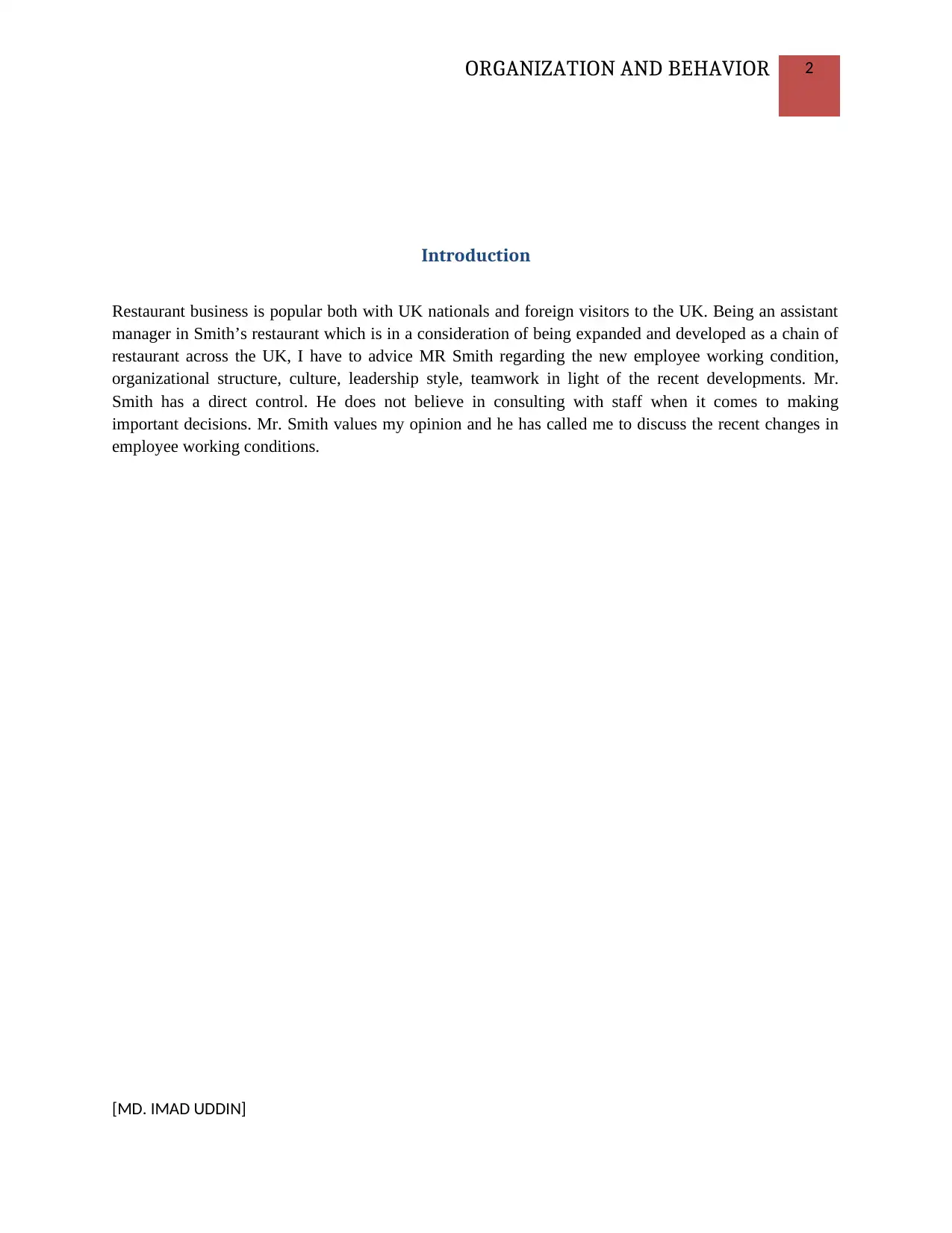
ORGANIZATION AND BEHAVIOR 2
Introduction
Restaurant business is popular both with UK nationals and foreign visitors to the UK. Being an assistant
manager in Smith’s restaurant which is in a consideration of being expanded and developed as a chain of
restaurant across the UK, I have to advice MR Smith regarding the new employee working condition,
organizational structure, culture, leadership style, teamwork in light of the recent developments. Mr.
Smith has a direct control. He does not believe in consulting with staff when it comes to making
important decisions. Mr. Smith values my opinion and he has called me to discuss the recent changes in
employee working conditions.
[MD. IMAD UDDIN]
Introduction
Restaurant business is popular both with UK nationals and foreign visitors to the UK. Being an assistant
manager in Smith’s restaurant which is in a consideration of being expanded and developed as a chain of
restaurant across the UK, I have to advice MR Smith regarding the new employee working condition,
organizational structure, culture, leadership style, teamwork in light of the recent developments. Mr.
Smith has a direct control. He does not believe in consulting with staff when it comes to making
important decisions. Mr. Smith values my opinion and he has called me to discuss the recent changes in
employee working conditions.
[MD. IMAD UDDIN]
⊘ This is a preview!⊘
Do you want full access?
Subscribe today to unlock all pages.

Trusted by 1+ million students worldwide
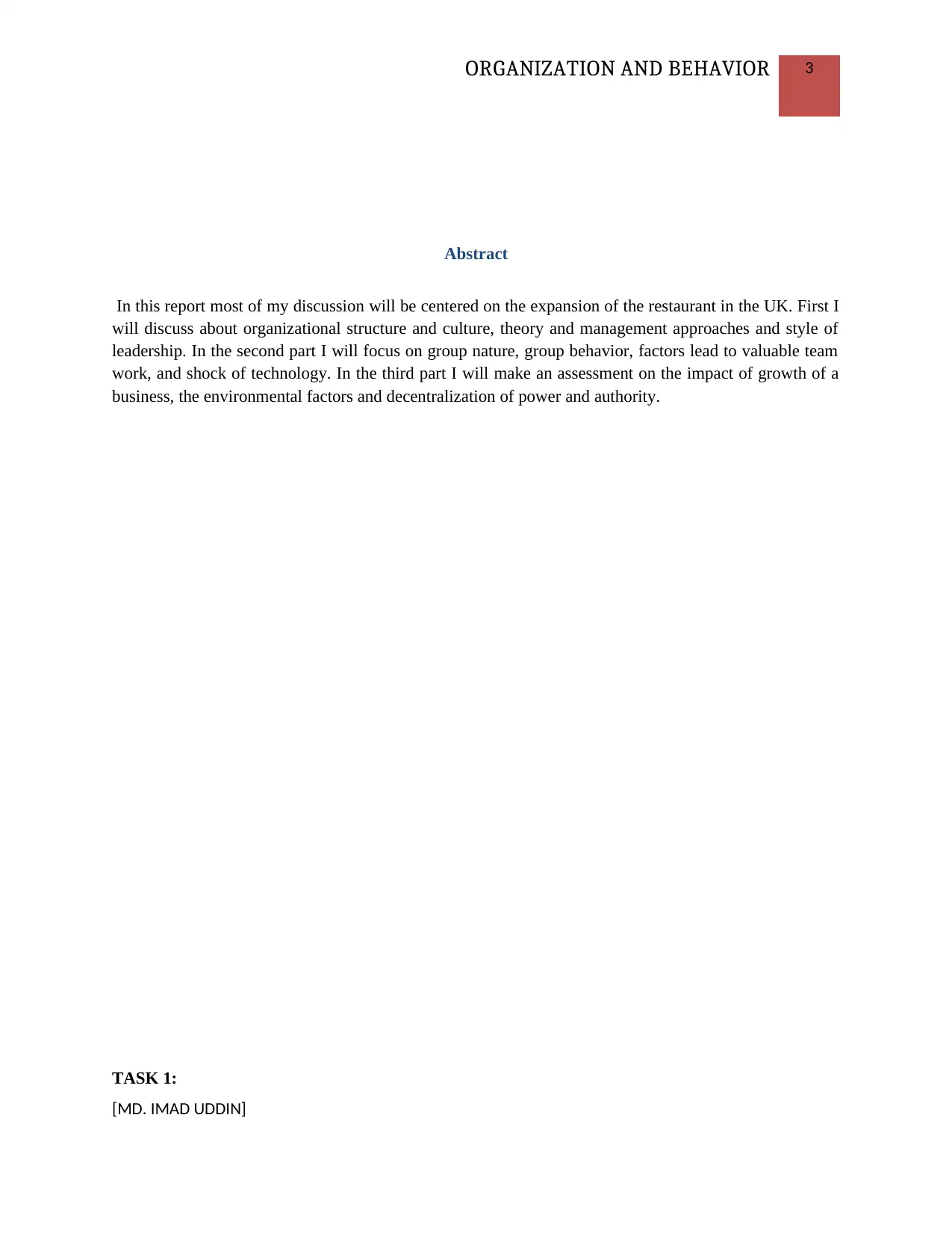
ORGANIZATION AND BEHAVIOR 3
Abstract
In this report most of my discussion will be centered on the expansion of the restaurant in the UK. First I
will discuss about organizational structure and culture, theory and management approaches and style of
leadership. In the second part I will focus on group nature, group behavior, factors lead to valuable team
work, and shock of technology. In the third part I will make an assessment on the impact of growth of a
business, the environmental factors and decentralization of power and authority.
TASK 1:
[MD. IMAD UDDIN]
Abstract
In this report most of my discussion will be centered on the expansion of the restaurant in the UK. First I
will discuss about organizational structure and culture, theory and management approaches and style of
leadership. In the second part I will focus on group nature, group behavior, factors lead to valuable team
work, and shock of technology. In the third part I will make an assessment on the impact of growth of a
business, the environmental factors and decentralization of power and authority.
TASK 1:
[MD. IMAD UDDIN]
Paraphrase This Document
Need a fresh take? Get an instant paraphrase of this document with our AI Paraphraser
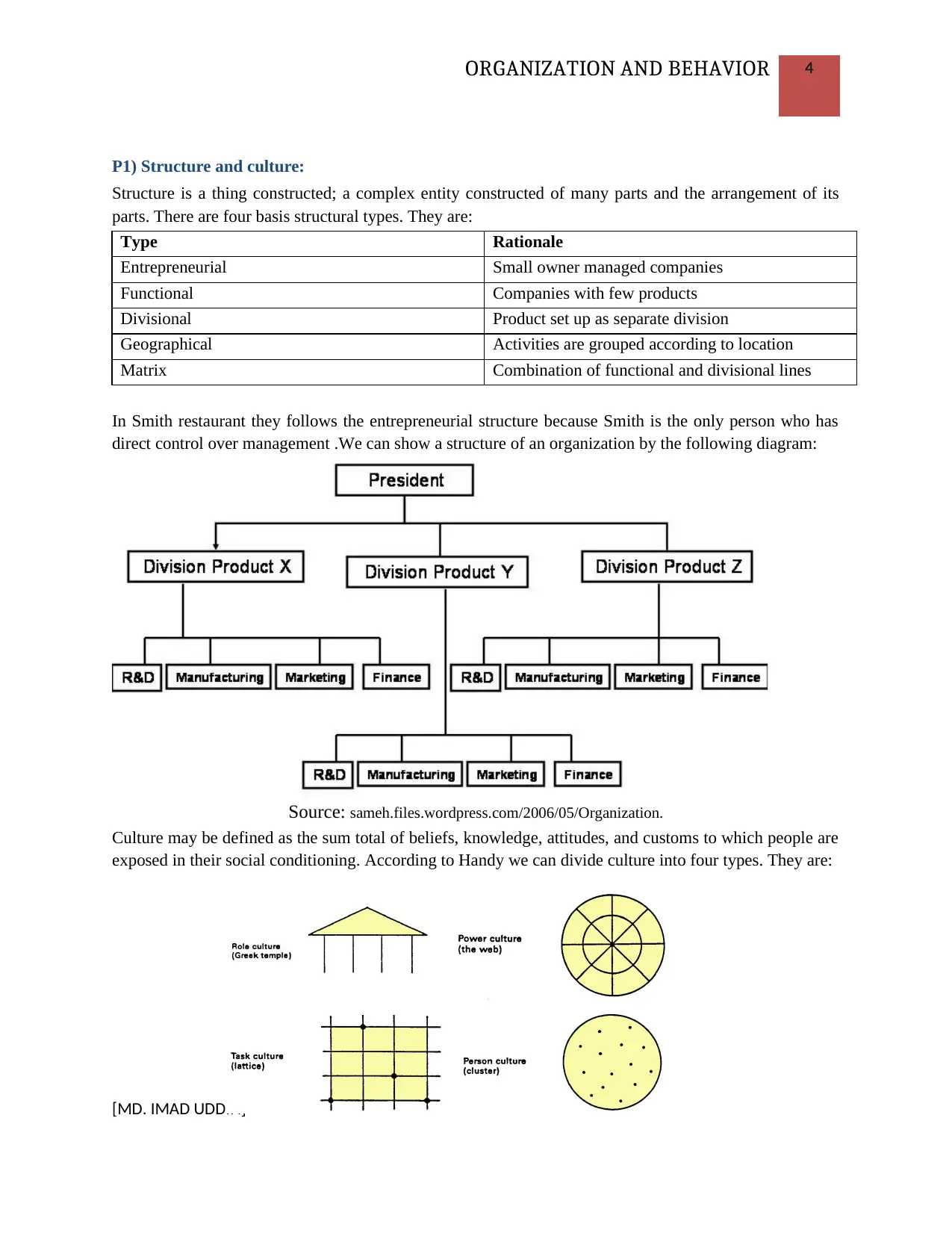
ORGANIZATION AND BEHAVIOR 4
P1) Structure and culture:
Structure is a thing constructed; a complex entity constructed of many parts and the arrangement of its
parts. There are four basis structural types. They are:
Type Rationale
Entrepreneurial Small owner managed companies
Functional Companies with few products
Divisional Product set up as separate division
Geographical Activities are grouped according to location
Matrix Combination of functional and divisional lines
In Smith restaurant they follows the entrepreneurial structure because Smith is the only person who has
direct control over management .We can show a structure of an organization by the following diagram:
Source: sameh.files.wordpress.com/2006/05/Organization.
Culture may be defined as the sum total of beliefs, knowledge, attitudes, and customs to which people are
exposed in their social conditioning. According to Handy we can divide culture into four types. They are:
[MD. IMAD UDDIN]
P1) Structure and culture:
Structure is a thing constructed; a complex entity constructed of many parts and the arrangement of its
parts. There are four basis structural types. They are:
Type Rationale
Entrepreneurial Small owner managed companies
Functional Companies with few products
Divisional Product set up as separate division
Geographical Activities are grouped according to location
Matrix Combination of functional and divisional lines
In Smith restaurant they follows the entrepreneurial structure because Smith is the only person who has
direct control over management .We can show a structure of an organization by the following diagram:
Source: sameh.files.wordpress.com/2006/05/Organization.
Culture may be defined as the sum total of beliefs, knowledge, attitudes, and customs to which people are
exposed in their social conditioning. According to Handy we can divide culture into four types. They are:
[MD. IMAD UDDIN]
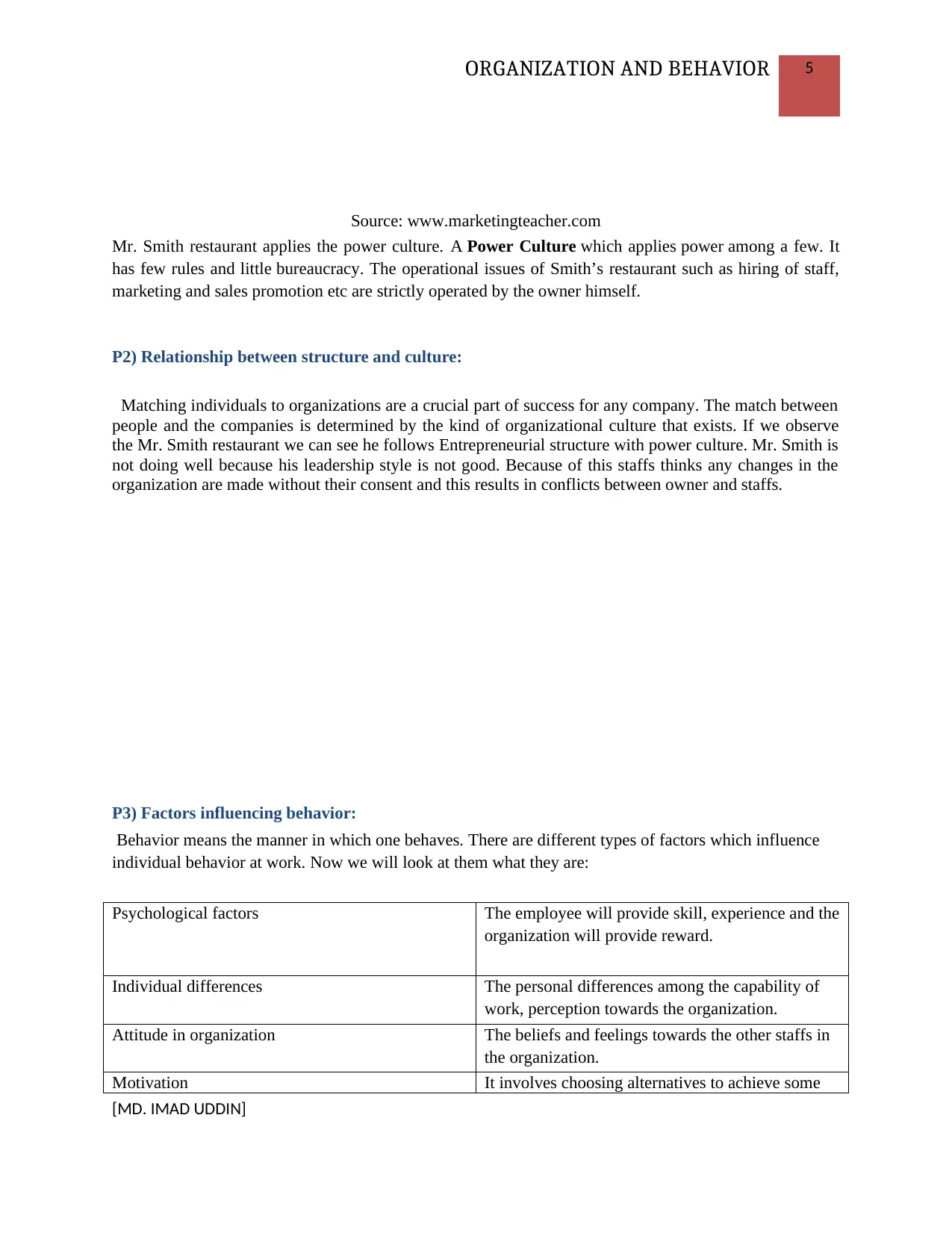
ORGANIZATION AND BEHAVIOR 5
Source: www.marketingteacher.com
Mr. Smith restaurant applies the power culture. A Power Culture which applies power among a few. It
has few rules and little bureaucracy. The operational issues of Smith’s restaurant such as hiring of staff,
marketing and sales promotion etc are strictly operated by the owner himself.
P2) Relationship between structure and culture:
Matching individuals to organizations are a crucial part of success for any company. The match between
people and the companies is determined by the kind of organizational culture that exists. If we observe
the Mr. Smith restaurant we can see he follows Entrepreneurial structure with power culture. Mr. Smith is
not doing well because his leadership style is not good. Because of this staffs thinks any changes in the
organization are made without their consent and this results in conflicts between owner and staffs.
P3) Factors influencing behavior:
Behavior means the manner in which one behaves. There are different types of factors which influence
individual behavior at work. Now we will look at them what they are:
Psychological factors The employee will provide skill, experience and the
organization will provide reward.
Individual differences The personal differences among the capability of
work, perception towards the organization.
Attitude in organization The beliefs and feelings towards the other staffs in
the organization.
Motivation It involves choosing alternatives to achieve some
[MD. IMAD UDDIN]
Source: www.marketingteacher.com
Mr. Smith restaurant applies the power culture. A Power Culture which applies power among a few. It
has few rules and little bureaucracy. The operational issues of Smith’s restaurant such as hiring of staff,
marketing and sales promotion etc are strictly operated by the owner himself.
P2) Relationship between structure and culture:
Matching individuals to organizations are a crucial part of success for any company. The match between
people and the companies is determined by the kind of organizational culture that exists. If we observe
the Mr. Smith restaurant we can see he follows Entrepreneurial structure with power culture. Mr. Smith is
not doing well because his leadership style is not good. Because of this staffs thinks any changes in the
organization are made without their consent and this results in conflicts between owner and staffs.
P3) Factors influencing behavior:
Behavior means the manner in which one behaves. There are different types of factors which influence
individual behavior at work. Now we will look at them what they are:
Psychological factors The employee will provide skill, experience and the
organization will provide reward.
Individual differences The personal differences among the capability of
work, perception towards the organization.
Attitude in organization The beliefs and feelings towards the other staffs in
the organization.
Motivation It involves choosing alternatives to achieve some
[MD. IMAD UDDIN]
⊘ This is a preview!⊘
Do you want full access?
Subscribe today to unlock all pages.

Trusted by 1+ million students worldwide
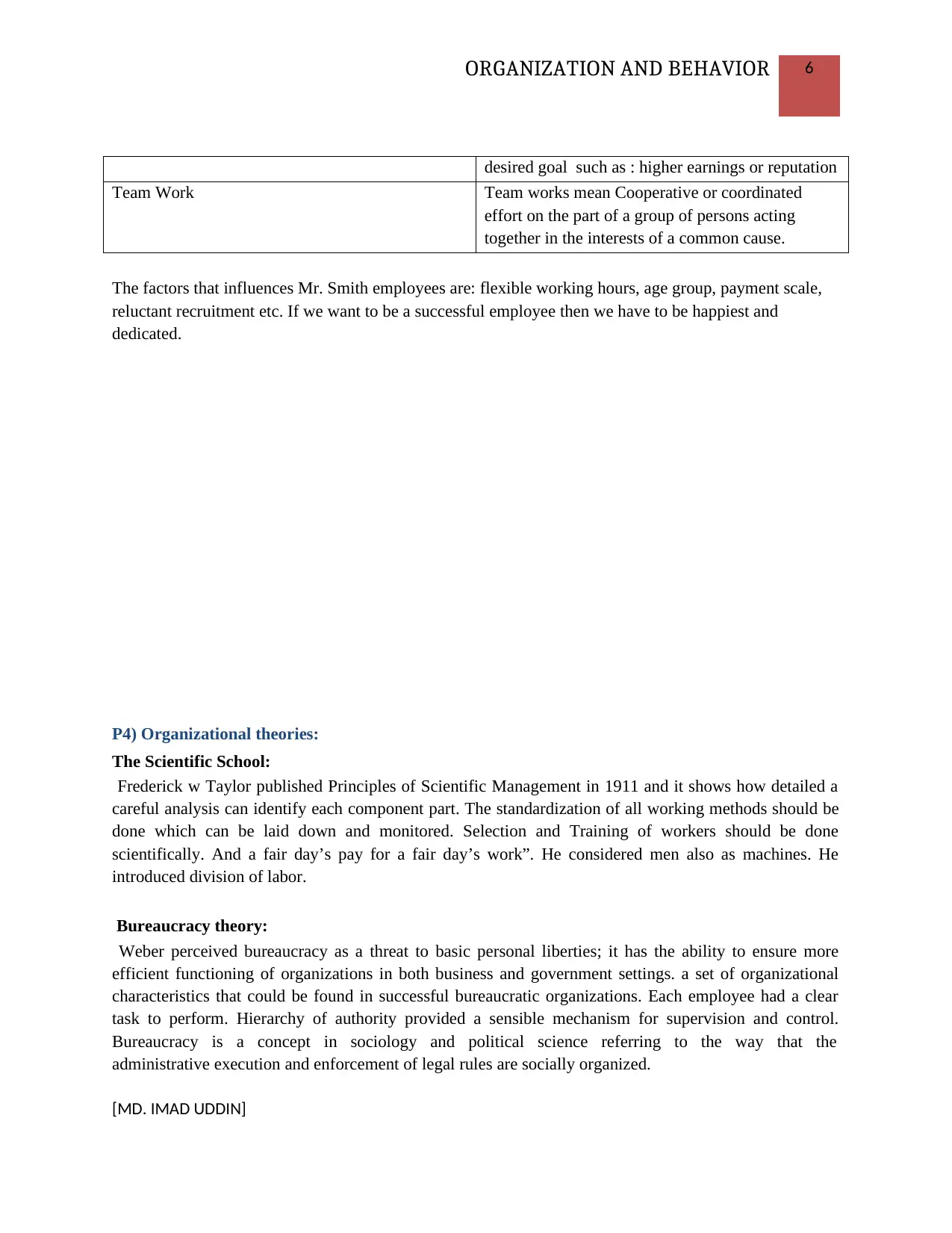
ORGANIZATION AND BEHAVIOR 6
desired goal such as : higher earnings or reputation
Team Work Team works mean Cooperative or coordinated
effort on the part of a group of persons acting
together in the interests of a common cause.
The factors that influences Mr. Smith employees are: flexible working hours, age group, payment scale,
reluctant recruitment etc. If we want to be a successful employee then we have to be happiest and
dedicated.
P4) Organizational theories:
The Scientific School:
Frederick w Taylor published Principles of Scientific Management in 1911 and it shows how detailed a
careful analysis can identify each component part. The standardization of all working methods should be
done which can be laid down and monitored. Selection and Training of workers should be done
scientifically. And a fair day’s pay for a fair day’s work”. He considered men also as machines. He
introduced division of labor.
Bureaucracy theory:
Weber perceived bureaucracy as a threat to basic personal liberties; it has the ability to ensure more
efficient functioning of organizations in both business and government settings. a set of organizational
characteristics that could be found in successful bureaucratic organizations. Each employee had a clear
task to perform. Hierarchy of authority provided a sensible mechanism for supervision and control.
Bureaucracy is a concept in sociology and political science referring to the way that the
administrative execution and enforcement of legal rules are socially organized.
[MD. IMAD UDDIN]
desired goal such as : higher earnings or reputation
Team Work Team works mean Cooperative or coordinated
effort on the part of a group of persons acting
together in the interests of a common cause.
The factors that influences Mr. Smith employees are: flexible working hours, age group, payment scale,
reluctant recruitment etc. If we want to be a successful employee then we have to be happiest and
dedicated.
P4) Organizational theories:
The Scientific School:
Frederick w Taylor published Principles of Scientific Management in 1911 and it shows how detailed a
careful analysis can identify each component part. The standardization of all working methods should be
done which can be laid down and monitored. Selection and Training of workers should be done
scientifically. And a fair day’s pay for a fair day’s work”. He considered men also as machines. He
introduced division of labor.
Bureaucracy theory:
Weber perceived bureaucracy as a threat to basic personal liberties; it has the ability to ensure more
efficient functioning of organizations in both business and government settings. a set of organizational
characteristics that could be found in successful bureaucratic organizations. Each employee had a clear
task to perform. Hierarchy of authority provided a sensible mechanism for supervision and control.
Bureaucracy is a concept in sociology and political science referring to the way that the
administrative execution and enforcement of legal rules are socially organized.
[MD. IMAD UDDIN]
Paraphrase This Document
Need a fresh take? Get an instant paraphrase of this document with our AI Paraphraser
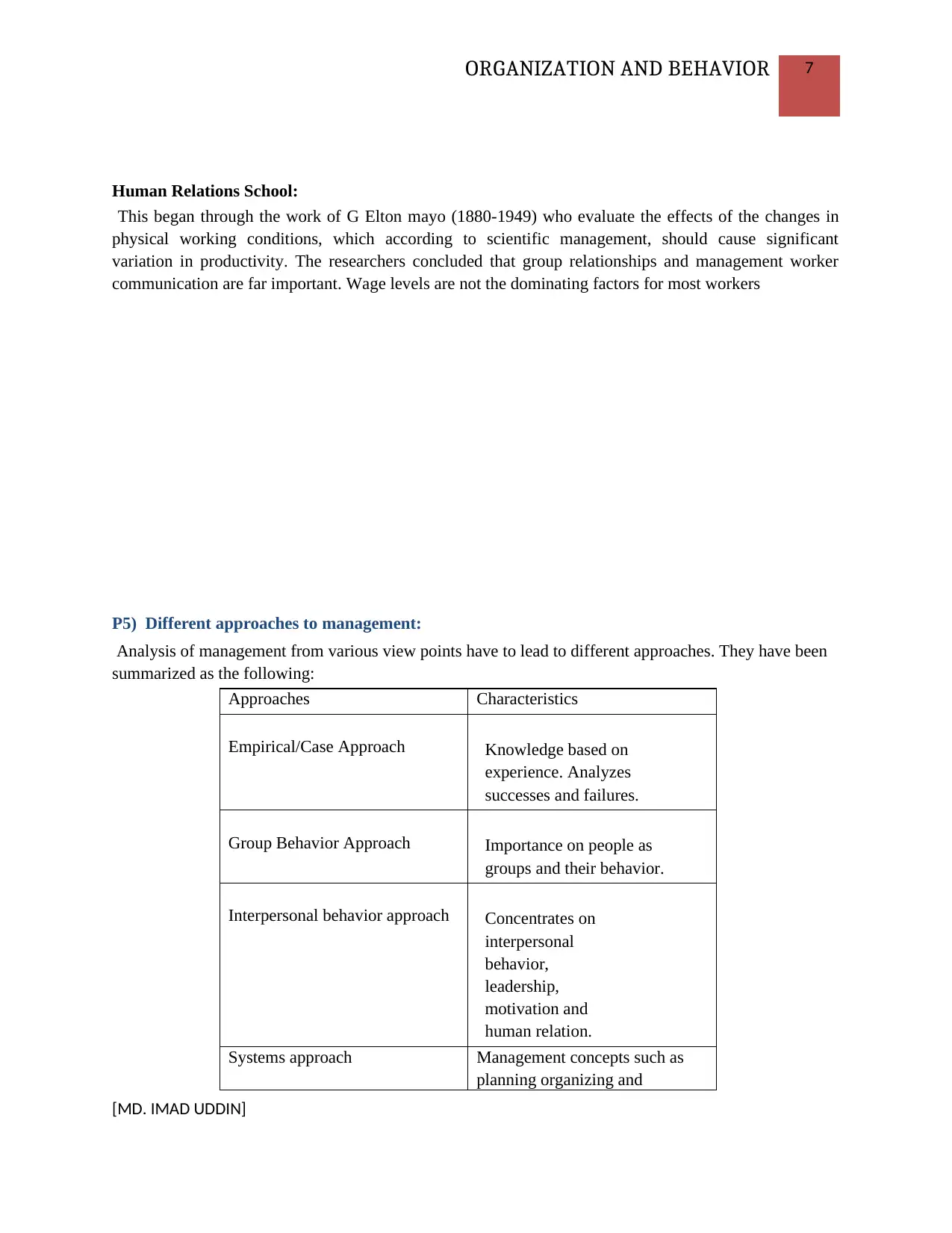
ORGANIZATION AND BEHAVIOR 7
Human Relations School:
This began through the work of G Elton mayo (1880-1949) who evaluate the effects of the changes in
physical working conditions, which according to scientific management, should cause significant
variation in productivity. The researchers concluded that group relationships and management worker
communication are far important. Wage levels are not the dominating factors for most workers
P5) Different approaches to management:
Analysis of management from various view points have to lead to different approaches. They have been
summarized as the following:
Approaches Characteristics
Empirical/Case Approach Knowledge based on
experience. Analyzes
successes and failures.
Group Behavior Approach Importance on people as
groups and their behavior.
Interpersonal behavior approach Concentrates on
interpersonal
behavior,
leadership,
motivation and
human relation.
Systems approach Management concepts such as
planning organizing and
[MD. IMAD UDDIN]
Human Relations School:
This began through the work of G Elton mayo (1880-1949) who evaluate the effects of the changes in
physical working conditions, which according to scientific management, should cause significant
variation in productivity. The researchers concluded that group relationships and management worker
communication are far important. Wage levels are not the dominating factors for most workers
P5) Different approaches to management:
Analysis of management from various view points have to lead to different approaches. They have been
summarized as the following:
Approaches Characteristics
Empirical/Case Approach Knowledge based on
experience. Analyzes
successes and failures.
Group Behavior Approach Importance on people as
groups and their behavior.
Interpersonal behavior approach Concentrates on
interpersonal
behavior,
leadership,
motivation and
human relation.
Systems approach Management concepts such as
planning organizing and
[MD. IMAD UDDIN]
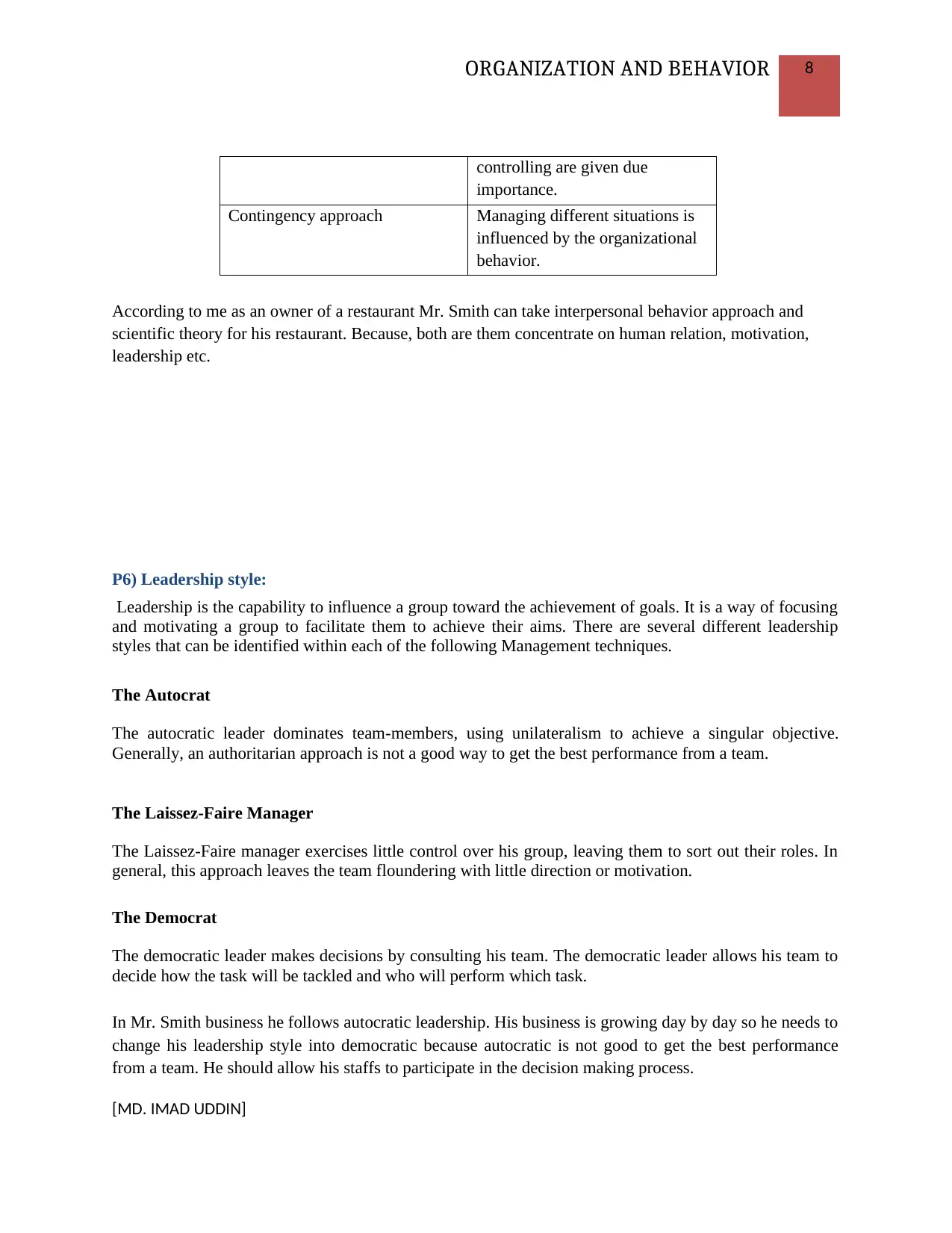
ORGANIZATION AND BEHAVIOR 8
controlling are given due
importance.
Contingency approach Managing different situations is
influenced by the organizational
behavior.
According to me as an owner of a restaurant Mr. Smith can take interpersonal behavior approach and
scientific theory for his restaurant. Because, both are them concentrate on human relation, motivation,
leadership etc.
P6) Leadership style:
Leadership is the capability to influence a group toward the achievement of goals. It is a way of focusing
and motivating a group to facilitate them to achieve their aims. There are several different leadership
styles that can be identified within each of the following Management techniques.
The Autocrat
The autocratic leader dominates team-members, using unilateralism to achieve a singular objective.
Generally, an authoritarian approach is not a good way to get the best performance from a team.
The Laissez-Faire Manager
The Laissez-Faire manager exercises little control over his group, leaving them to sort out their roles. In
general, this approach leaves the team floundering with little direction or motivation.
The Democrat
The democratic leader makes decisions by consulting his team. The democratic leader allows his team to
decide how the task will be tackled and who will perform which task.
In Mr. Smith business he follows autocratic leadership. His business is growing day by day so he needs to
change his leadership style into democratic because autocratic is not good to get the best performance
from a team. He should allow his staffs to participate in the decision making process.
[MD. IMAD UDDIN]
controlling are given due
importance.
Contingency approach Managing different situations is
influenced by the organizational
behavior.
According to me as an owner of a restaurant Mr. Smith can take interpersonal behavior approach and
scientific theory for his restaurant. Because, both are them concentrate on human relation, motivation,
leadership etc.
P6) Leadership style:
Leadership is the capability to influence a group toward the achievement of goals. It is a way of focusing
and motivating a group to facilitate them to achieve their aims. There are several different leadership
styles that can be identified within each of the following Management techniques.
The Autocrat
The autocratic leader dominates team-members, using unilateralism to achieve a singular objective.
Generally, an authoritarian approach is not a good way to get the best performance from a team.
The Laissez-Faire Manager
The Laissez-Faire manager exercises little control over his group, leaving them to sort out their roles. In
general, this approach leaves the team floundering with little direction or motivation.
The Democrat
The democratic leader makes decisions by consulting his team. The democratic leader allows his team to
decide how the task will be tackled and who will perform which task.
In Mr. Smith business he follows autocratic leadership. His business is growing day by day so he needs to
change his leadership style into democratic because autocratic is not good to get the best performance
from a team. He should allow his staffs to participate in the decision making process.
[MD. IMAD UDDIN]
⊘ This is a preview!⊘
Do you want full access?
Subscribe today to unlock all pages.

Trusted by 1+ million students worldwide
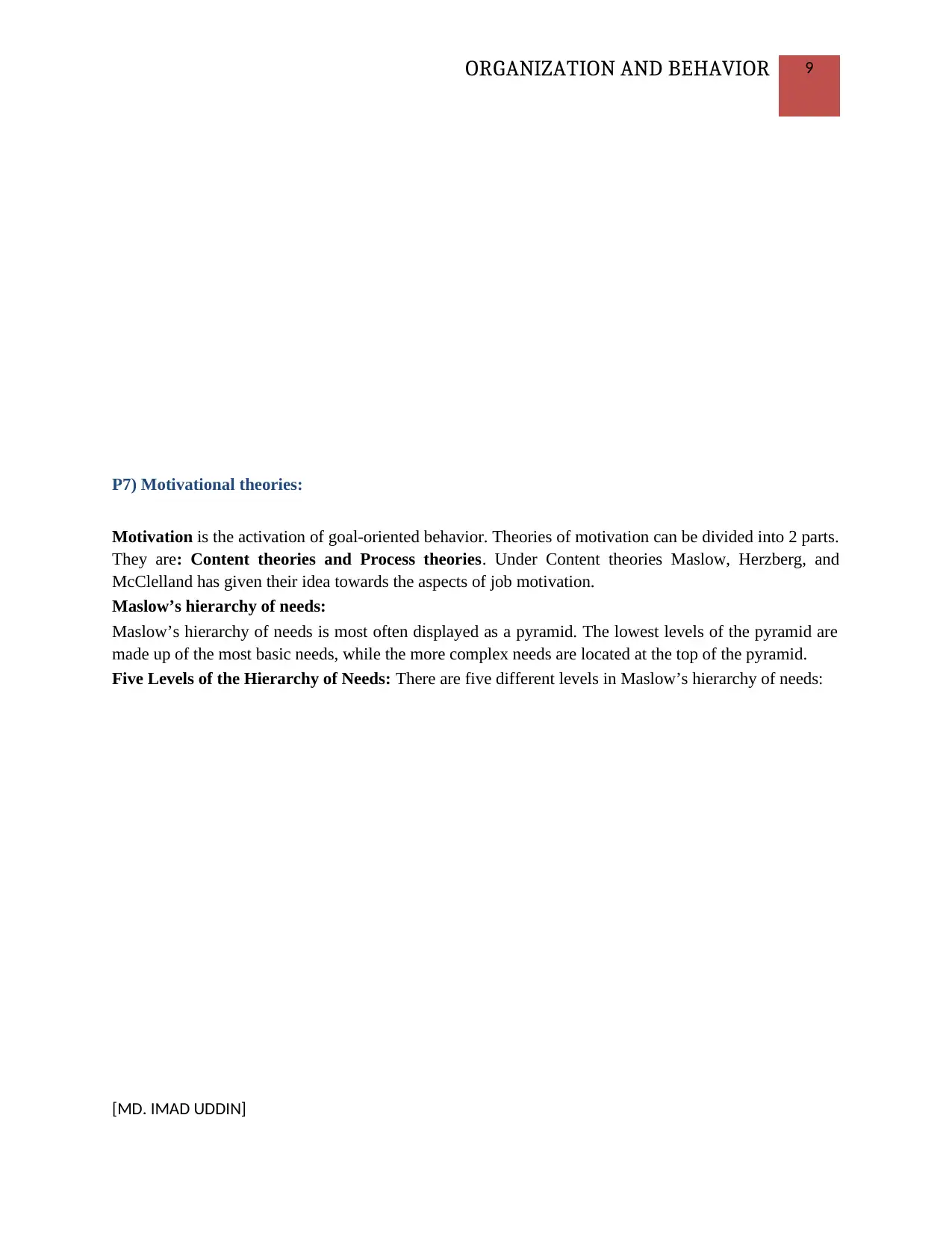
ORGANIZATION AND BEHAVIOR 9
P7) Motivational theories:
Motivation is the activation of goal-oriented behavior. Theories of motivation can be divided into 2 parts.
They are: Content theories and Process theories. Under Content theories Maslow, Herzberg, and
McClelland has given their idea towards the aspects of job motivation.
Maslow’s hierarchy of needs:
Maslow’s hierarchy of needs is most often displayed as a pyramid. The lowest levels of the pyramid are
made up of the most basic needs, while the more complex needs are located at the top of the pyramid.
Five Levels of the Hierarchy of Needs: There are five different levels in Maslow’s hierarchy of needs:
[MD. IMAD UDDIN]
P7) Motivational theories:
Motivation is the activation of goal-oriented behavior. Theories of motivation can be divided into 2 parts.
They are: Content theories and Process theories. Under Content theories Maslow, Herzberg, and
McClelland has given their idea towards the aspects of job motivation.
Maslow’s hierarchy of needs:
Maslow’s hierarchy of needs is most often displayed as a pyramid. The lowest levels of the pyramid are
made up of the most basic needs, while the more complex needs are located at the top of the pyramid.
Five Levels of the Hierarchy of Needs: There are five different levels in Maslow’s hierarchy of needs:
[MD. IMAD UDDIN]
Paraphrase This Document
Need a fresh take? Get an instant paraphrase of this document with our AI Paraphraser
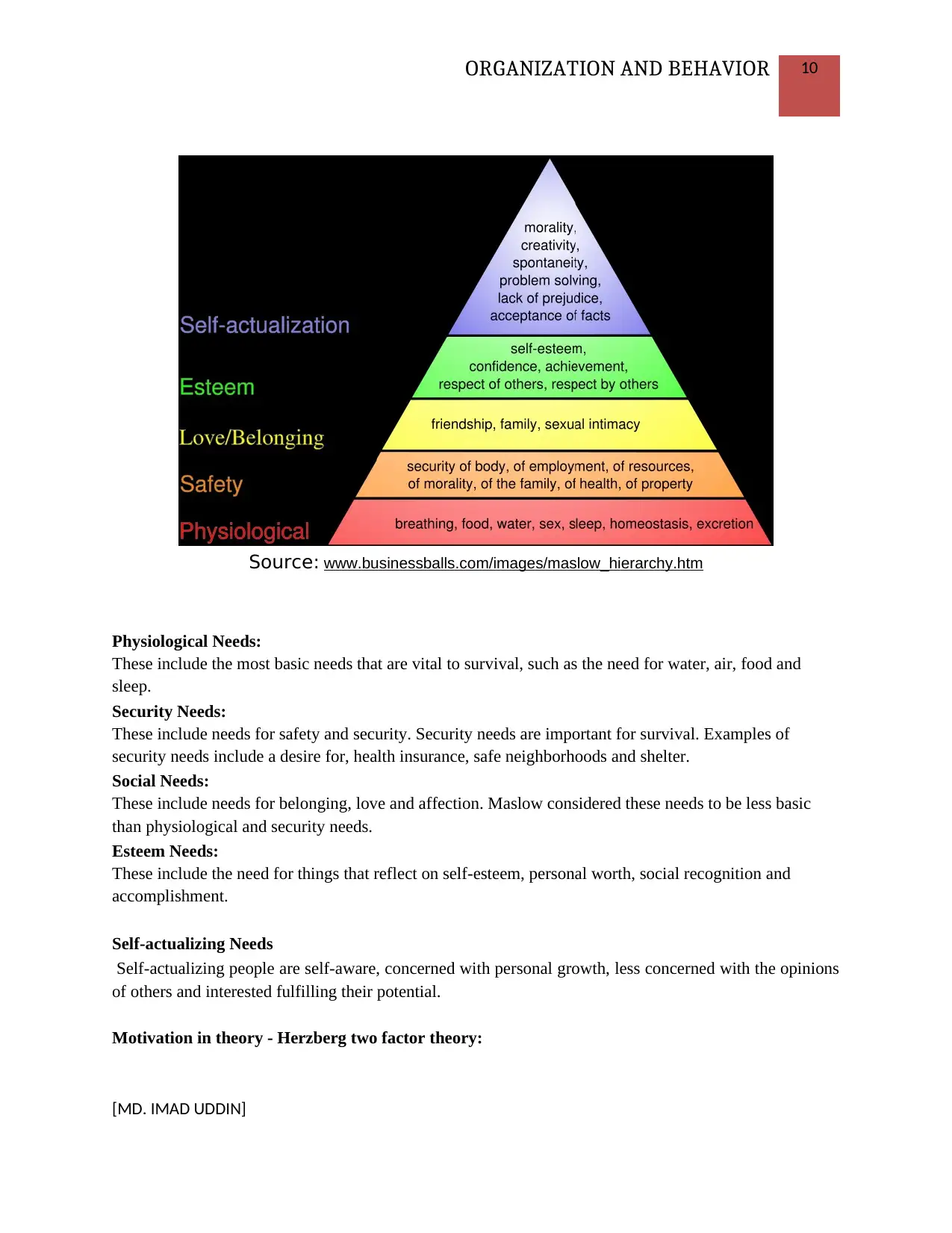
ORGANIZATION AND BEHAVIOR 10
Source: www.businessballs.com/images/maslow_hierarchy.htm
Physiological Needs:
These include the most basic needs that are vital to survival, such as the need for water, air, food and
sleep.
Security Needs:
These include needs for safety and security. Security needs are important for survival. Examples of
security needs include a desire for, health insurance, safe neighborhoods and shelter.
Social Needs:
These include needs for belonging, love and affection. Maslow considered these needs to be less basic
than physiological and security needs.
Esteem Needs:
These include the need for things that reflect on self-esteem, personal worth, social recognition and
accomplishment.
Self-actualizing Needs
Self-actualizing people are self-aware, concerned with personal growth, less concerned with the opinions
of others and interested fulfilling their potential.
Motivation in theory - Herzberg two factor theory:
[MD. IMAD UDDIN]
Source: www.businessballs.com/images/maslow_hierarchy.htm
Physiological Needs:
These include the most basic needs that are vital to survival, such as the need for water, air, food and
sleep.
Security Needs:
These include needs for safety and security. Security needs are important for survival. Examples of
security needs include a desire for, health insurance, safe neighborhoods and shelter.
Social Needs:
These include needs for belonging, love and affection. Maslow considered these needs to be less basic
than physiological and security needs.
Esteem Needs:
These include the need for things that reflect on self-esteem, personal worth, social recognition and
accomplishment.
Self-actualizing Needs
Self-actualizing people are self-aware, concerned with personal growth, less concerned with the opinions
of others and interested fulfilling their potential.
Motivation in theory - Herzberg two factor theory:
[MD. IMAD UDDIN]
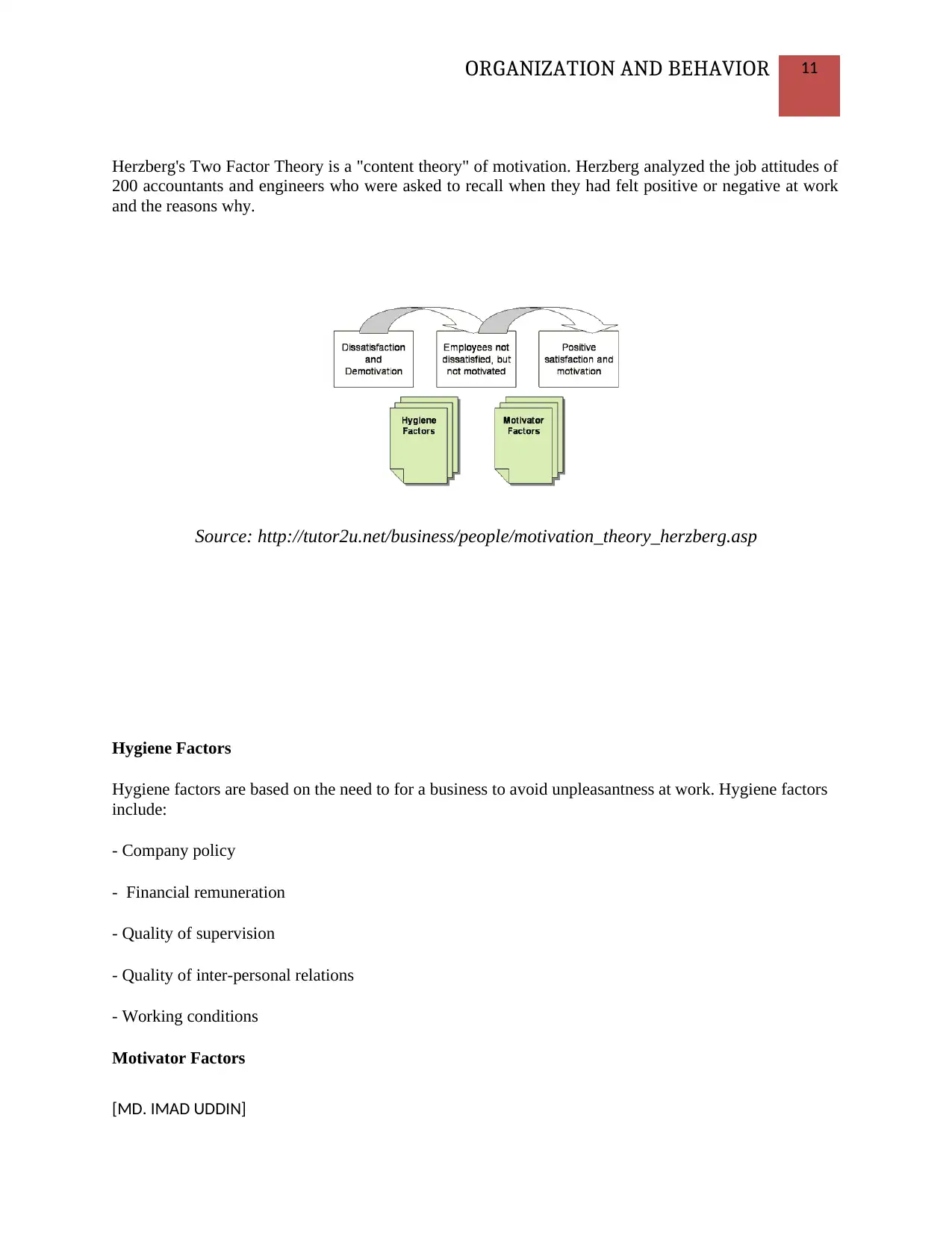
ORGANIZATION AND BEHAVIOR 11
Herzberg's Two Factor Theory is a "content theory" of motivation. Herzberg analyzed the job attitudes of
200 accountants and engineers who were asked to recall when they had felt positive or negative at work
and the reasons why.
Source: http://tutor2u.net/business/people/motivation_theory_herzberg.asp
Hygiene Factors
Hygiene factors are based on the need to for a business to avoid unpleasantness at work. Hygiene factors
include:
- Company policy
- Financial remuneration
- Quality of supervision
- Quality of inter-personal relations
- Working conditions
Motivator Factors
[MD. IMAD UDDIN]
Herzberg's Two Factor Theory is a "content theory" of motivation. Herzberg analyzed the job attitudes of
200 accountants and engineers who were asked to recall when they had felt positive or negative at work
and the reasons why.
Source: http://tutor2u.net/business/people/motivation_theory_herzberg.asp
Hygiene Factors
Hygiene factors are based on the need to for a business to avoid unpleasantness at work. Hygiene factors
include:
- Company policy
- Financial remuneration
- Quality of supervision
- Quality of inter-personal relations
- Working conditions
Motivator Factors
[MD. IMAD UDDIN]
⊘ This is a preview!⊘
Do you want full access?
Subscribe today to unlock all pages.

Trusted by 1+ million students worldwide
1 out of 22
Related Documents
Your All-in-One AI-Powered Toolkit for Academic Success.
+13062052269
info@desklib.com
Available 24*7 on WhatsApp / Email
![[object Object]](/_next/static/media/star-bottom.7253800d.svg)
Unlock your academic potential
Copyright © 2020–2025 A2Z Services. All Rights Reserved. Developed and managed by ZUCOL.





